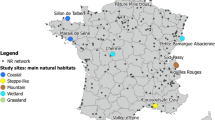Abstract
Ecologists are developing methods for the design of reserve systems, but non-ecological factors or criteria may limit their applicability (e.g. threat, initiative, low-cost ‘opportunities’). Threat before reserve acquisition (i.e. direct threat, contributing to reserve establishment) and the actors proposing reserves were studied for a random sample of 84 nature reserves with forest in southern Sweden, established 1926–1996. A direct threat was recorded for about 40% of these reserves before they were acquired. The remaining reserves had not been directly threatened, although indirect threat probably contributed to establishment of several reserves. Threat was an important factor in this productive lowland area, but for reserves in larger regions with varied topography (e.g. Sweden) mainly alpine or low-productive areas is represented, and threat seems to be of minor importance. Decisions for the 84 reserves were taken by one main conservation agency, which however initiated less than 50% of the reserves. External actors, such as other authorities, idealistic organisations and private individuals were also important initiators, suggesting that actors in the reserve process should be studied in biodiversity programs. Strong arguments for protection, careful planning, and flexibility with respect to non-ecological factors (that probably cannot be eliminated) may be successful tactics to establish more reserves with high biological values.
Similar content being viewed by others
References
Berg Å, Ehnström B, Gustafsson L, Hallingbäck T, Jonsell M and Weslien J (1994) Threatened plant, animal, and fungus species in Swedish forests: distribution and habitat associations. Conservation Biology 8: 718–731
Berg Å and Tjernberg M (1996) Common and rare Swedish vertebrates-distribution and habitat preferences. Biodiversity and Conservation 5: 101–128
Bibby CJ (1998) Selecting areas for conservation. In: Sutherland WJ (ed) Conservation Science and Action, pp 176–201. Blackwell, London
Ehrlich PR and Ehrlich AE (1992) The value of biodiversity. Ambio 21: 219–226
Esseen P-A, Ehnström B, Ericsson L and Sjöberg K (1997) Boreal forests. In: Hansson L (ed) Boreal Ecosystems and Landscapes: Structures, Processes and Conservation of Biodiversity, pp 16–47. Ecological Bull. No. 46
Götmark F and Nilsson C (1992) Criteria used for protection of natural areas in Sweden 1909–1986. Conservation Biology 6: 220–231
Hansson L (ed) (1997) Boreal ecosystems and landscapes: structures, processes and conservation. Ecological Bull. 46: 1–203
Howard PC et al. (1998) Complementarity and the use of indicator groups for reserve selection in Uganda. Nature 394: 472–475
McNeely JN (1994) Protected areas for the 21st century: working to provide benefits to society. Biodiversity and Conservation 3: 390–405
Meffe G and Carroll R (1997) Principles of Conservation Biology. Sinauer Press
Moore NW (1987) The bird of time. The science and politics of nature conservation. Cambridge University Press, Cambridge
Nilsson C and Götmark F (1992) Protected areas in Sweden: is natural variety adequately represented? Conservation Biology 6: 232–242
Pressey RL (1994) Ad hoc reservation: forward or backward steps in developing representative reserve systems? Conservation Biology 8: 662–668
Pressey RL, Humphries CJ, Margules CR, Vane-Wright RI and Williams PH (1993) Beyond opportunism: key principles for systematic reserve selection. Trends Ecology Evolution 8: 124–128
Pressey RL, Ferrier S, Hager TC, Woods CA, Tully SL and Weinmann KM (1996) How well protected are the forests of north-eastern New South Wales?-analyses of forest environments in relation to formal protection measures, land tenure, and vulnerability to clearing. Forestry Ecology Management 85: 311–333
Reid WV (1998) Biodiversity hotspots. Trends Ecology Evolution 13: 275–280
Rodgers WH et al. (1993) Setting Priorities for Land Conservation. National Research Council. National Academy of Sciences Press, USA
RRV (Riksrevisionsverket) (1998:62) Skyddas värdefull natur? RRV 1998: 62, 341 pp. Stockholm (also www.rrv.se). (Protection of valuable natural habitats? Swedish National Audit Bureau)
Runte A (1987) National Parks: The American Experience. University of Nebraska Press, Lincoln, Nebraska
SEPA (Swedish Environmental Protection Agency) (1997) Skogsreservat i Sverige (Forest reserves in Sweden). Naturvårdsverket Rapport 4707
SFS (Svensk författningssamling) (1991: 641) Naturvårdslagen (Nature Conservation Act). Stockholm
Smith PGR and Theberge JB (1986) A review of criteria for evaluating natural areas. Environmental Management 10: 715–734
SOU (Sveriges offentliga utredningar) (1997: 97–98) Skydd av skogsmark (97), Bilagor (98). Miljödepartementet, Stockholm. (Swedish Public Reports. Protection of forests (97), Appendix (98))
Soulé ME and Simberloff D (1986) What do genetics and ecology tell us about the design of nature reserves? Biological Conservation 35: 19–40
Spellerberg IF (1992) Evaluation and Assessment for Conservation: Ecological Guidelines for Determining Priorities for Nature Conservation. Chapman & Hall, London
Usher MB (ed) (1986) Wildlife Conservation Evaluation. Chapman & Hall, London
Author information
Authors and Affiliations
Rights and permissions
About this article
Cite this article
Emneborg, H., Götmark, F. The role of threat to areas and initiative from actors for establishment of nature reserves in southern Sweden 1926–1996. Biodiversity and Conservation 9, 727–738 (2000). https://doi.org/10.1023/A:1008993710490
Issue Date:
DOI: https://doi.org/10.1023/A:1008993710490




